Learning Russian grammatical cases is often perceived as a formidable challenge by learners of the Russian language. The Russian declension system is notably complex: nouns, all types of pronouns, adjectives, and numerals must be declined according to grammatical number (singular or plural), gender, and case. In total, Russian comprises six grammatical cases: Nominative, Genitive, Dative, Accusative, Instrumental, and Prepositional.
While it may seem discouraging that mastery of all six cases is essential for speaking Russian both fluently and accurately, there is encouraging news: effective methods do exist. The fundamental principle for successfully learning Russian cases is straightforward—they should always be studied in context, through short stories, songs, dialogues, and other meaningful linguistic material.
One of the most challenging and perplexing cases in Russian grammar is the Genitive case. Its primary function is to express possession or ownership, a role that in English is typically conveyed by the apostrophe ’s or the preposition of. However, in Russian, the Genitive case extends far beyond this basic notion of possession and appears in numerous contexts where the connection is not immediately apparent.
The diverse functions of the Genitive case can indeed be difficult to master. To facilitate understanding and retention, it may be helpful to associate the Genitive case with the concept of a “house,” examining the various “rooms” or situations in which it is applied:
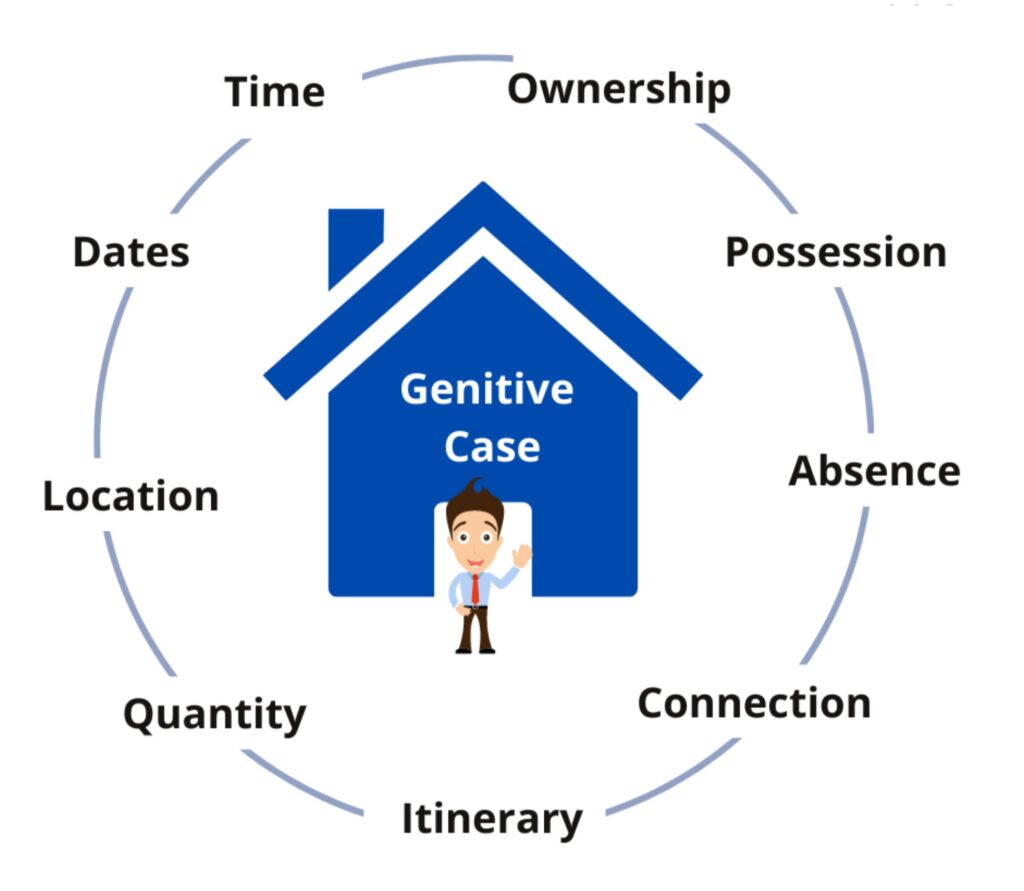
Overall, it becomes clear that these situations share significant similarities and are closely interrelated. In addition, the Genitive case is required with a number of specific prepositions and verbs that must be learned separately. As there are numerous contexts in which the Genitive case is obligatory, mastering it is essential for developing confident and accurate speech in Russian.
The first step in mastering the Genitive case is learning how to modify noun endings when transitioning from the Nominative case. Unfortunately, many available rules on the internet tend to be overly complex, as they often fail to present the broader logic and structure underlying these endings. Moreover, they frequently list endings in isolation, without providing clear illustrative examples.
It is important not to memorize the endings mechanically. Instead, they should be learned in context, accompanied by examples. Below is a table showing singular noun endings in the Genitive case. These tables have been specifically designed to make the learning process more accessible. Endings of the Nominative case are highlighted in green, while those of the Genitive case appear in red. Note that the grammatical gender of a noun plays a crucial role in determining the appropriate ending.
Endings for singular nouns in the Genitive case
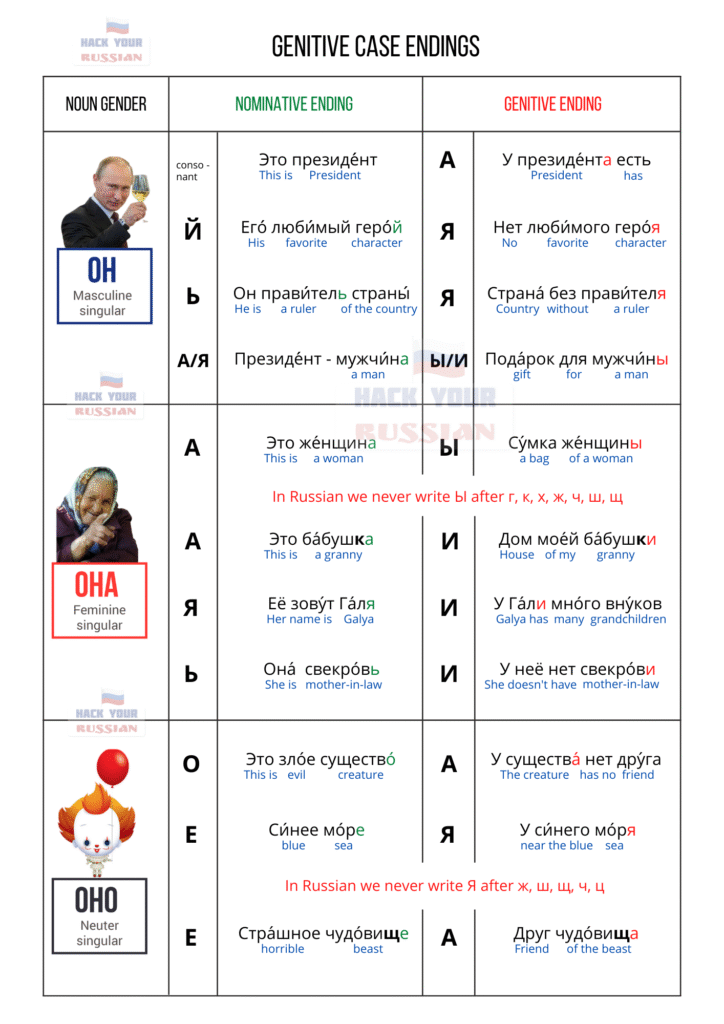
Let’s sum up the Genitive case endings for singular nouns and create a clear system out of it to make it more simple.
Before doing this, let’s learn some important definitions:
- A stem of a word – the whole word without ending
- Soft consonants – consonants followed by the letters и, е, ё, ю, я and a soft sign. The letters ч, щ, й are always soft.
- Hard consonants – all other consonants except for the soft.
You need to know what consonant stands in the end of the word stem to put the correct ending. Just look how simple it is!
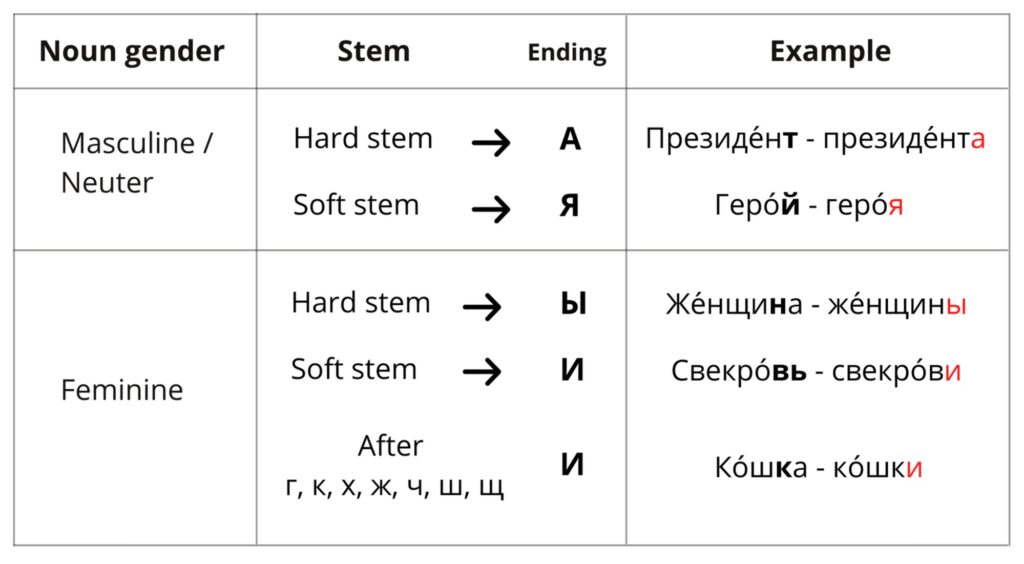
To make it easier for you to remember these endings, memorize them in example sentences. You can create your own or use mine:
У президе́нта нет люби́мого геро́я (The President doesn’t have a favorite character / hero).
У свекро́ви э́той же́нщины две ко́шки (The mother-in-law of this woman has two cats).
So, we know how to change endings for singular nouns in the Genitive case. But what about plural nouns in the Genitive case. Have a look at the table below.
Endings for plural nouns in the Genitive case
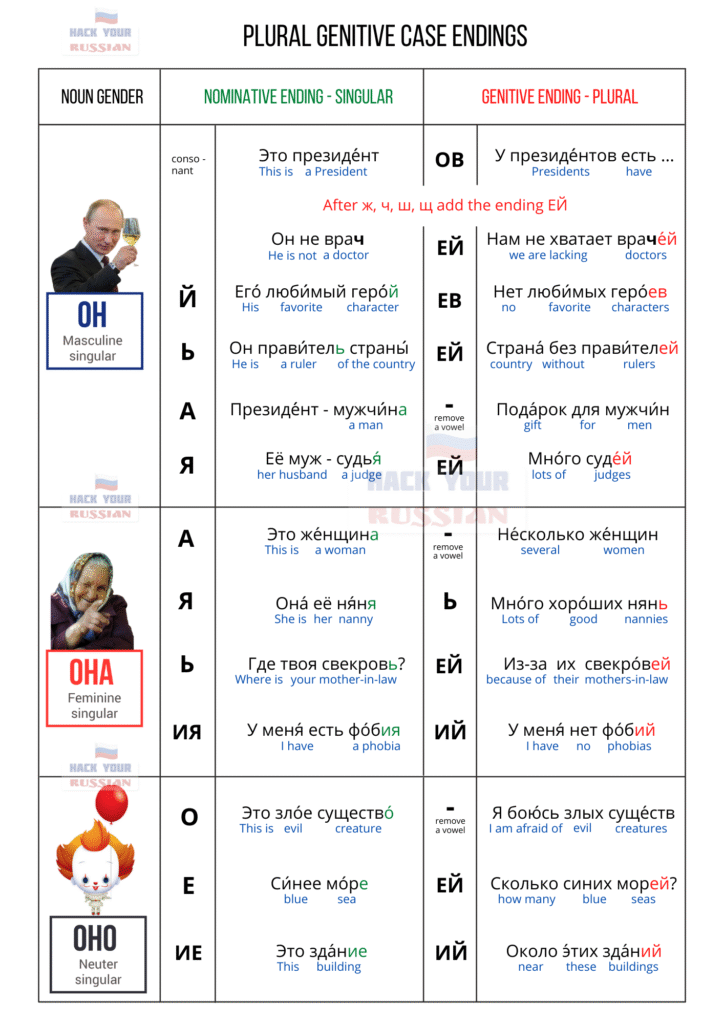
Let’s now sum up the Genitive case endings for plural nouns and create a clear system out of it to make it more simple.
But as you could notice, it will be a more complicated system. We can divide these changes into two groups: when we remove a vowel at the end of the word and when we add something at the end of the word. Let’s look at the rules!
Verdict: Remove it!
We remove the last letter of the word when it ends with a vowel sound. For example, подруга (a female friend) – подруг (female friends in the Genitive case).
It’s very important to know the difference between a sound and a letter here. In Russian, there are 4 vowels that consist of two sounds: Е [й+э], Ё [й+о], Ю [й+у], Я [й+а]. Example word – яблоко [йАблака] – an apple.
However, when it stands after a consonant it loses it’s [й] part and softens this consonant. And the softness in Russian is shown with the soft sign (ь) or with an apostrophe in transcription. Therefore, in words like няня [ньАньа or н’Ан’а] – a nanny, we need to remove the last vowel sound А, so we have a soft sign in the end – нянь [ньАнь or н’Ан’].
But what about the endings -ИЕ and -ИЯ? As you could see these endings change into -ИЙ in the Genitive case. So, you are probably thinking now that these are just the exceptions. But no, we also remove the last vowel sound in these endings. Let me prove it to you!
So, we have a word фобия (a phobia) which is transcribed as [фОбийа]. The last vowel sound is А, so we just remove it [фОбий]. You see, this is really that simple!
Just add it!
Let’s now look at situations when we need to add an ending to plural words in the Genitive case.
We add -ЕЙ when a noun ends with ж, ч, ш, щ, ь. For example: врач – враче́й, прави́тель – прави́телей, свекро́вь – свекро́вей.
If it is a noun of a masculine gender, you need to use the rule of hard and soft stems. When a stem of the word ends with a hard consonant, we add the ending -ОВ: президе́нт – президе́нтов.
When a stem ends with a soft consonant or –Й (which is soft by default), we add –ЕВ: геро́й – геро́ев.
And there is also an ending -ЁВ which is quite rare in words but you need to know it anyway. We use -ЁВ when the stress relocates to the ending of the word: край (an edge)– краёв, бой (a fight) – боёв.
Let’s summarize what we have just learned in a clear table:
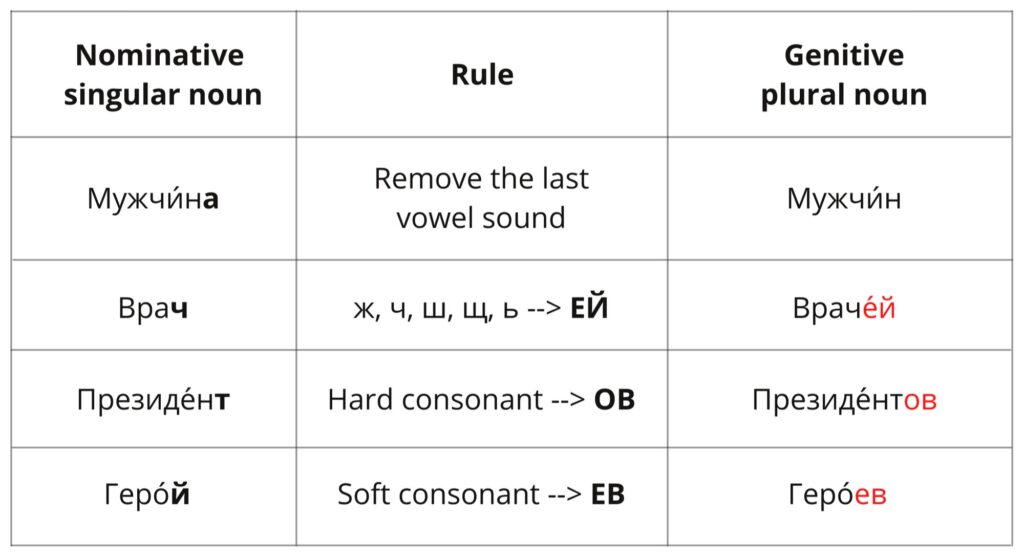
Let’s look at this example sentence that summarizes all the previous rules.
Среди́ мужчи́н мно́го изве́стных президе́нтов, враче́й и геро́ев без фо́бий (Among men there are a lot of famous Presidents, doctors and heroes without phobias).
*Words in bald are the triggers (words / prepositions that trigger us to use the Genitive case)
Again, you can create your own example sentences. They can be funny and simply hilarious. The most important is to make them memorable.
As you can see, the endings of the Russian Genitive case are not as difficult to learn as they may initially appear. There is a clear system underlying them, which can be understood and internalized with the right approach. However, mastering noun endings alone is not sufficient. It is equally important to learn the corresponding case endings for adjectives and pronouns, as these elements decline together with the noun and must agree with it in gender, number, and case.
Endings for singular adjectives in the Genitive case
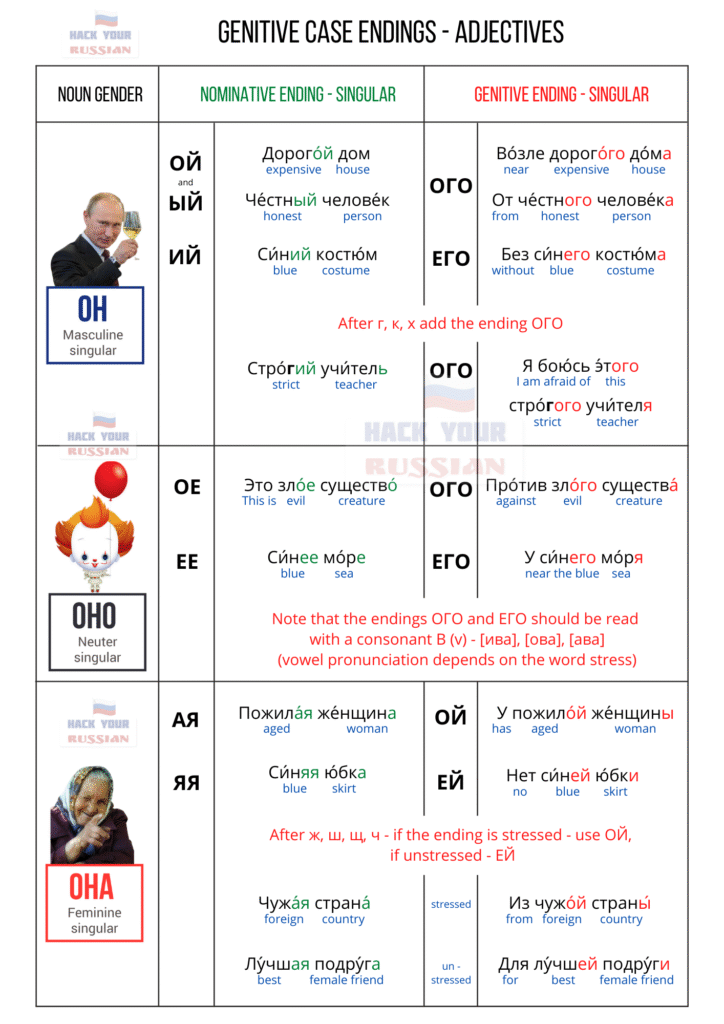
Let’s sum up the Genitive case endings for singular adjectives andcreate a clear system out of it to make it more simple.
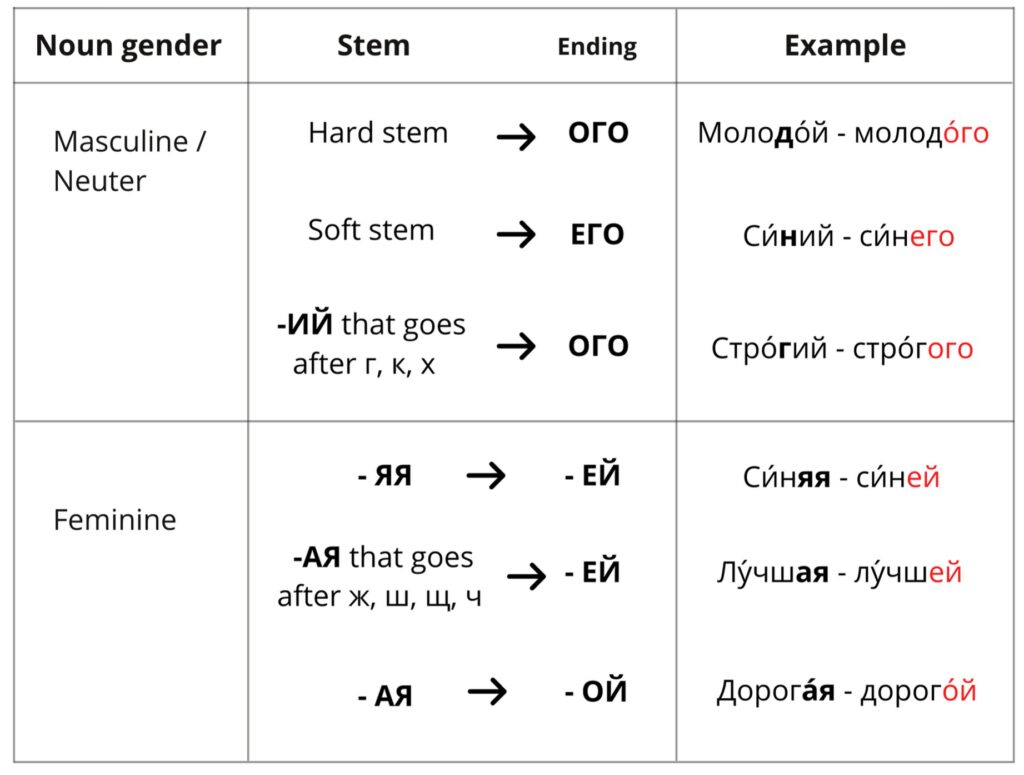
Rules for masculine and neutral adjectives:
If a stem ends with a hard consonant, change the ending to -ОГО. Ex.: отли́чный -> отли́чного (excellent).
When a stem of a word ends with -ИЙ and a stem ends up with one of the special letters (г, к, х) – change the ending to -ОГО. Ex.: ма́ленький -> ма́ленького (small, little).
However, if a word ends with a soft consonant, we should change the ending to -ЕГО. Ex.: ра́нний -> ра́ннего (early).
Rules for feminine adjectives:
If a word ends with -ЯЯ, change this ending to -ЕЙ. Ex.: Ex.: дома́шняя -> дома́шней (homemade).
If an adjective ends with -АЯ that goes after ж, ш, ч, щ change this ending to -ЕЙ. Ex.: хоро́шая -> хоро́шей (good).
If a feminine adjective ends with -АЯ, change this ending to -ОЙ. Ex.: изве́стная -> изве́стной (famous).
Find below two example sentences to remember these rules.
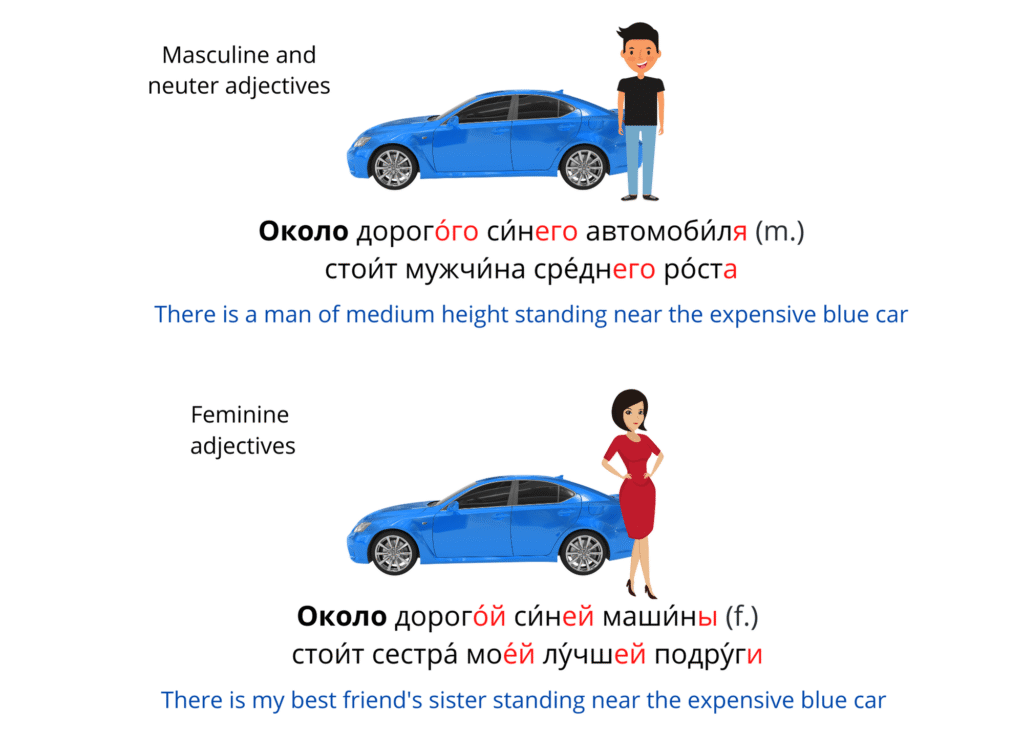
Endings for plural adjectives in the Genitive case
It’s very easy to form plural adjectives in the Genitive case since plural adjectives in the Nominative case can only have 2 possible endings: – ЫЕ and – ИЕ (all genders).
Adjectives ending with – ЫЕ will have an ending – ЫХ in the Genitive case
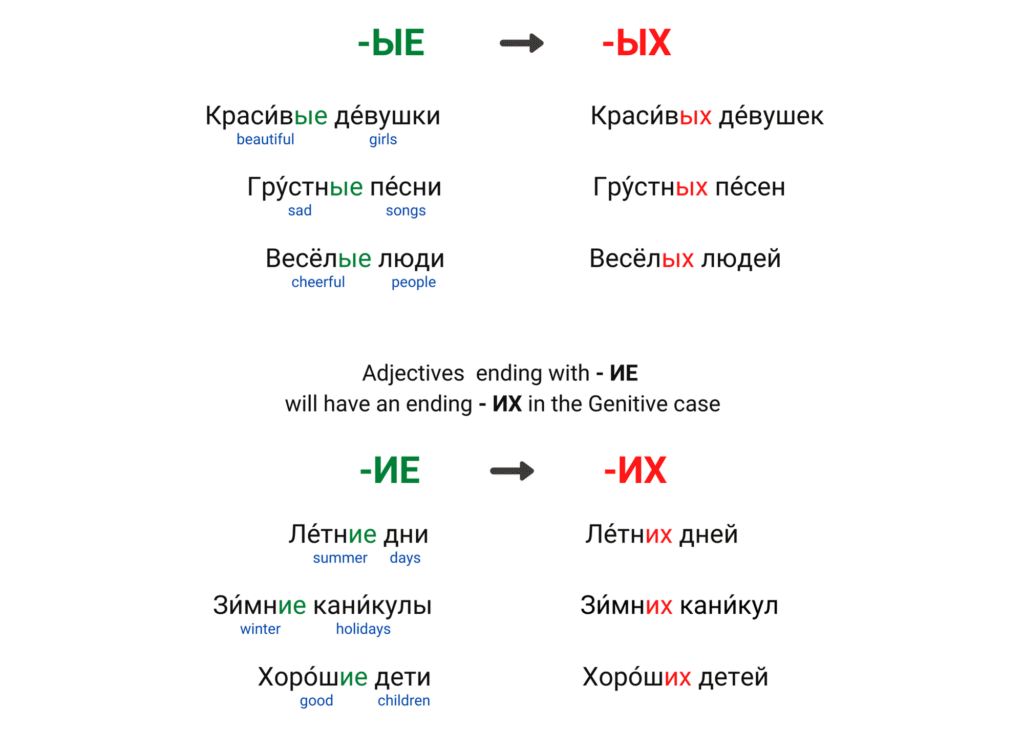
So, when is the Russian Genitive case used? Let us consider the most common situations:
- Possession. We use the Genitive case to show a possessor (both animate and inanimate objects). Ex.: У меня́ есть кот (I have a cat).
- Negation and Absence. Used to express the absence or non-existence of a person or object in the present, past, or future. Ex.: У дру́га нет маши́ны (a friend doesn’t have a car).
- Ownership and Relationship. Indicates that something belongs to someone or shows the relationship between two nouns. Ex.: Э́то кни́га бра́та (This is my brother’s book).
- Partitive Meaning / Part of a Whole. Expresses a part of a whole or an indefinite quantity of something. Ex.: Стака́н воды́ (a glass of water).
- Quantity and Units of Measurement. Used with numbers, quantitative expressions, and units of measurement. Ex.: Килогра́мм са́хара (a kilogram of sugar).
- After Certain Prepositions. Common prepositions requiring the Genitive include: без (without), до (until/before), после (after), около (around), вокруг (around), из (from/out of), от (from), с (from), у (at/by), etc. Ex.: У зда́ния (near the building).
- Dates and Time. To respond to the question Когда? (when?) if one needs to specify a particular date (day with a month or/and a year). Ex.: Мой день рожде́ния двена́дцатого ма́рта (My birthday is on the 12th of March).
- Comparison. Used in comparative constructions. Ex.: Он ста́рше бра́та (He is older than his brother).
- With Verbs Requiring the Genitive Case. Certain verbs govern the Genitive case. Ex.: Бою́сь темноты́ (I am afraid of the dark), добива́ться успе́ха (to strive for success).
- Fixed Expressions and Idioms. Set phrases that conventionally use the Genitive case.
These are not all situations when the Genitive case is needed. If you wish to learn the Russian Genitive case effectively, you should check out my guide to the Genitive case. This guide is not a simple book with grammar explanations. It is a whole course that will help you master the Russian Genitive case in a fun, engaging and easy way. Learning Russian cases can be a really daunting task if you use wrong materials with boring grammar explanations and complicated tables of endings. But this guide will show you that you can hack this system and understand how it works instead of merely memorizing tons of information.
I have created this guide because I couldn’t find a good book with easy, entertaining and full explanations of Russian cases. The majority of books just provide short and boring grammar explanations with no real-life examples and ready constructions to use. That is why many foreigners get frustrated as they cannot see the whole picture of each case. In this guide, you will find all possible situations when the Genitive case is needed. Moreover, you will learn lots of fixed expressions with the Genitive case that you will be able to use in your speech. The key to learning any grammar topics is through the context. You will discover some interesting tasks that will make you speak and use the Genitive case straight away.
And the ‘treasure’ of this guide is a final story about a man named Gena (association with the Genitive case). This story contains all situations that require the use of the Genitive case. This story was created based on a TPRS method (Teaching Proficiency through Reading and Storytelling) that is extremely effective for learning new languages. And in the end of the book you will find a good bonus that will put your Russian on the next level!

More guides to Russian cases to discover







